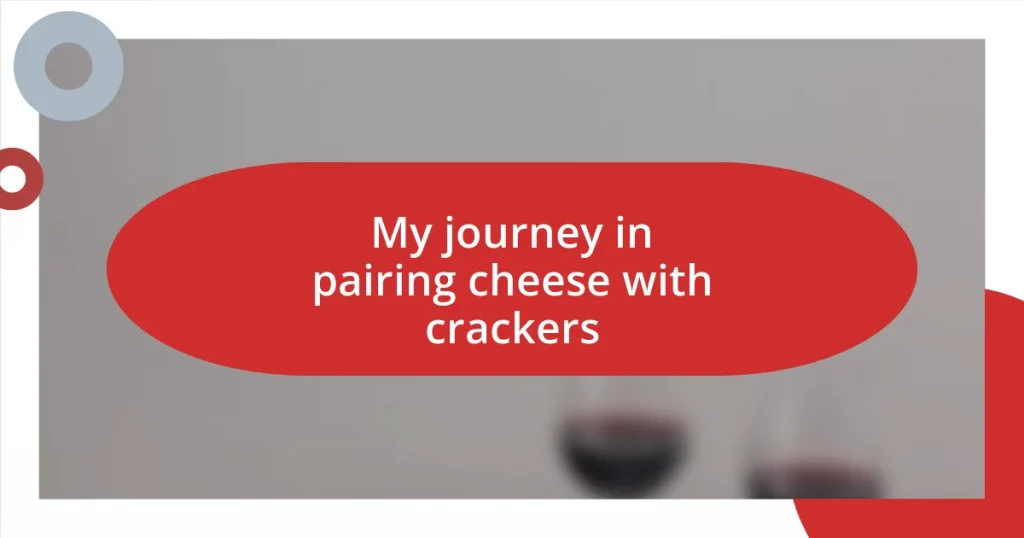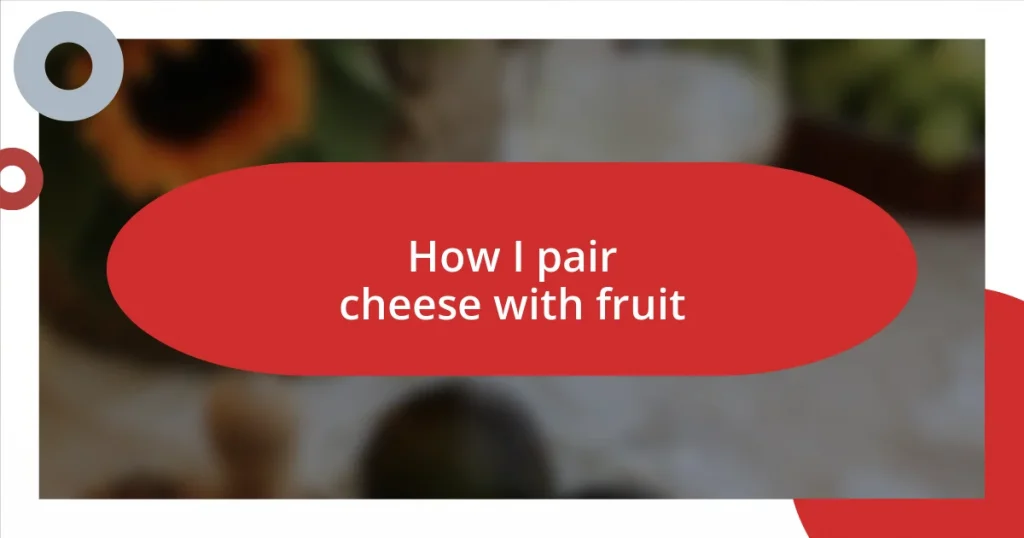Key takeaways:
- Understanding the textures and flavors of both cheese and crackers enhances the pairing experience, allowing for delightful culinary discoveries.
- Complementary cheese and cracker combinations are crucial; pairing sharper cheeses with sweeter or nuttier crackers can create unexpected yet delicious contrasts.
- Additional toppings and thoughtful wine pairings can elevate the experience, transforming simple snacks into memorable gourmet delights.
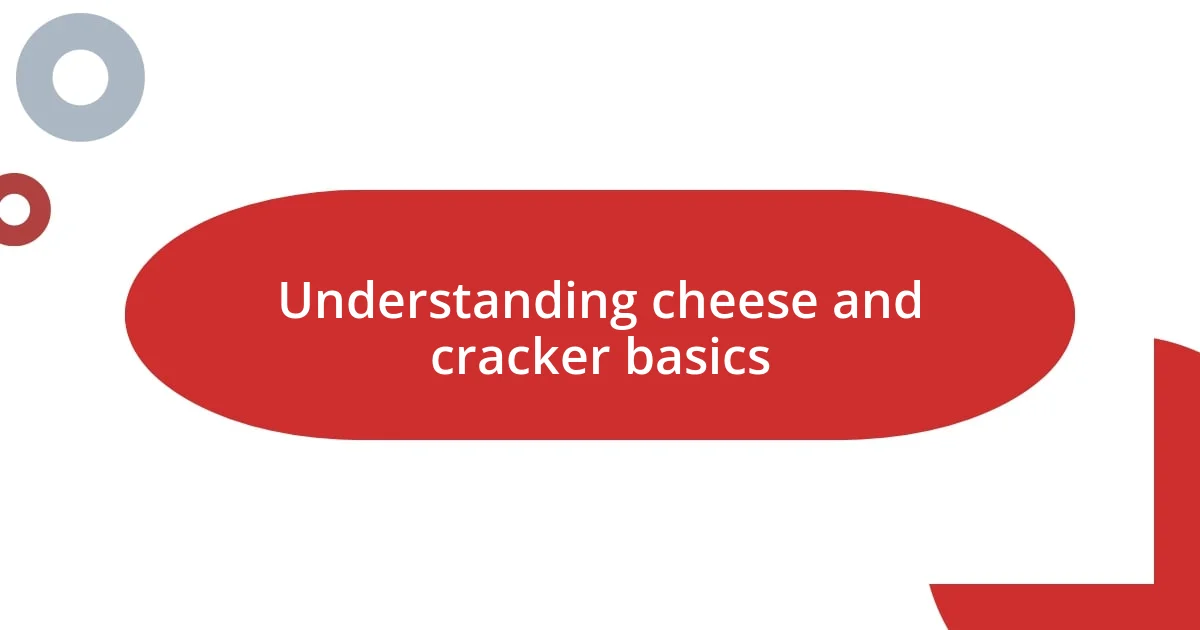
Understanding cheese and cracker basics
When I first explored the world of cheese and crackers, I was surprised by the sheer variety available. Just think about it: there are soft cheeses like Brie that melt in your mouth, and sharp cheddars that pack a flavorful punch. Pairing these with different textures of crackers can elevate the experience, turning a simple snack into a gourmet delight.
I’ve found that understanding the textures of cheese and crackers is key. Crispy, buttery crackers complement creamy cheeses beautifully, while heartier options balance the richness of aged varieties. Have you ever taken a bite that left you wondering how you missed such a perfect combination before? That’s the magic of experimentation, and trust me, it can be a delicious journey.
The flavors play a vital role, too. Pairing mild cheeses with subtly flavored crackers can create a harmonious balance, while contrasting flavors can funk things up. Personally, I remember that first time I paired a tangy goat cheese with a spicy cracker—it was a revelation! It’s about finding what excites your palate, and there’s no wrong answer when it comes to enjoying this simple yet complex pairing.
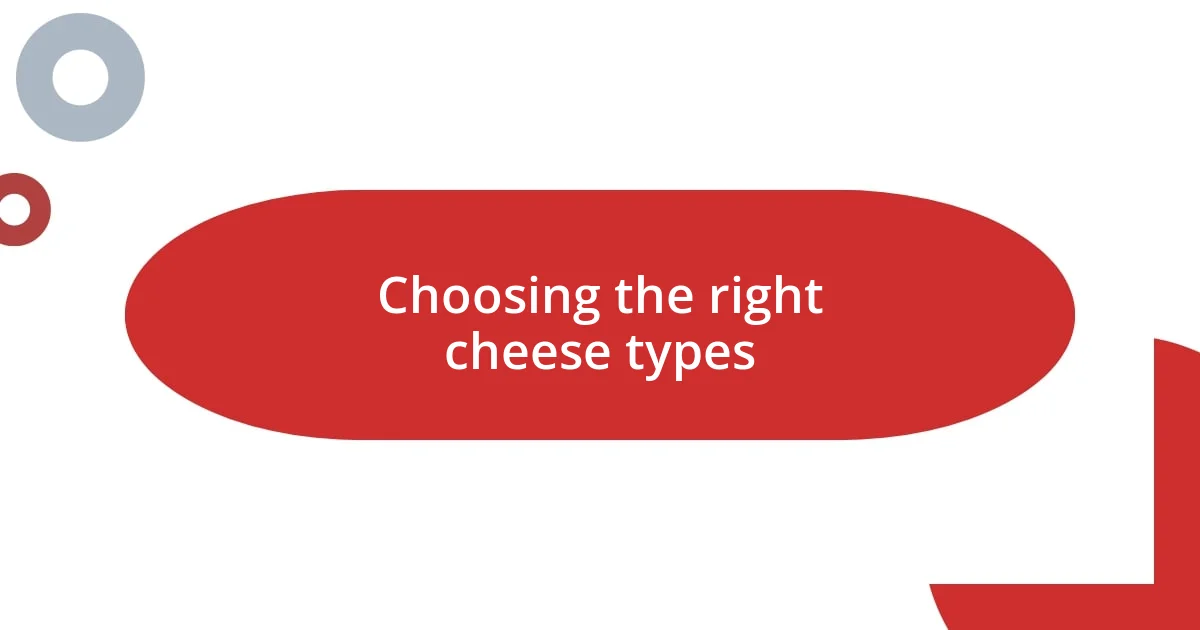
Choosing the right cheese types
Choosing the right cheese is akin to finding the perfect partner for your favorite dance. Each cheese type brings its unique character, soaking into the experience like a good melody. For instance, I still remember the first time I tasted a nutty Gruyère alongside a crunchy whole grain cracker. The combination was not just delicious; it was an unexpected harmony that made my taste buds dance with joy.
When selecting cheese for your cracker pairing, consider these types:
- Fresh Cheeses (e.g., mozzarella, ricotta): They’re light and creamy, best with mild, buttery crackers.
- Semi-Hard Cheeses (e.g., Gouda, Havarti): Their nutty flavors pair wonderfully with crisp, plain crackers or those with herbs.
- Hard Cheeses (e.g., aged cheddar, Parmigiano-Reggiano): These bold cheeses demand sturdier crackers like water biscuits or rye crisps to support their flavors.
- Blue Cheeses (e.g., Roquefort, Gorgonzola): They balance well with sweet or nutty crackers, such as those with honey or fig.
- Goat Cheese: Its tangy zest is sensational with mild, flaky crackers, offering a contrast that can surprise your taste buds.
Each cheese type can evoke different emotions and memories, transforming an ordinary snack into a personal journey of flavors. Trust your instincts; the delightful adventure of pairing is yours to explore!

Selecting complementary cracker varieties
Selecting the right cracker can significantly enhance a cheese pairing experience. For example, I’ve had moments where a simple saltine just didn’t cut it next to a rich Brie. Instead, I found that a rosemary-infused cracker brought out the subtle herby notes of the cheese and made the experience feel elevated and special. Have you ever tried pairing crackers that have a hint of sweetness with a sharp cheddar? It might sound unusual, but those surprises are often where the best flavors collide.
When it comes to selecting complementary cracker varieties, I’ve come to appreciate the importance of texture as well. For instance, a sturdy cracker is perfect when you’re dipping it into a gooey Camembert, while a wafer-thin cracker can beautifully highlight the creaminess of a goat cheese without overwhelming it. It’s all about balance. I recall a gathering where I set out a platter with several textures. Watching my friends delight in discovering their favorite combinations was a joyful reminder that texture can make all the difference in this culinary exploration.
Let’s not forget about flavor profiles, either. A lightly flavored cracker can be ideal for mild cheeses, while something with a bit of spice can awaken the taste buds next to a mellow cheese. For instance, I vividly remember indulging in a sweet fig cracker with a tangy blue cheese—an unexpected yet delightful revelation that had everyone raving. That’s the beauty of curating a thoughtful spread; it turns every bite into an adventure waiting to be discovered.
| Cracker Type | Complementary Cheese Types |
|---|---|
| Crispy Crackers | Soft and Creamy Cheeses (e.g., Brie, Camembert) |
| Herbed Crackers | Semi-Hard Cheeses (e.g., Gouda, Havarti) |
| Whole Grain Crackers | Hard Cheeses (e.g., Aged Cheddar) |
| Sweet Crackers | Blue Cheeses (e.g., Roquefort) |
| Flaky Crackers | Goat Cheese |
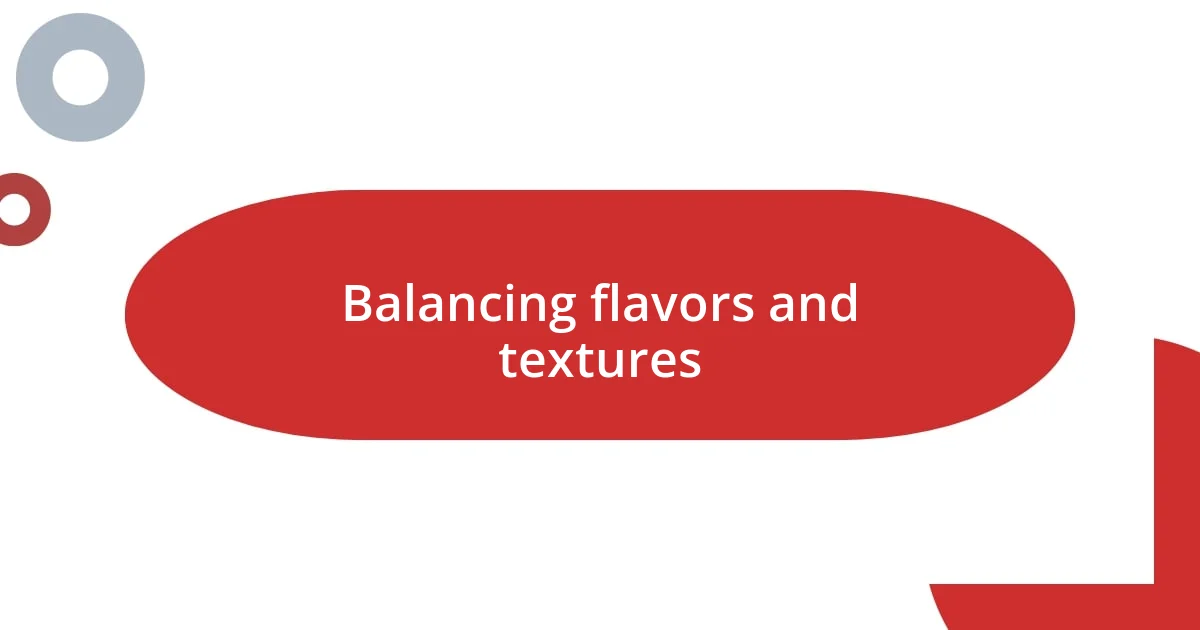
Balancing flavors and textures
Balancing flavors and textures is truly an art. I remember one evening, experimenting with a velvety Brie and a charcoal cracker. The contrast was like a gentle tug-of-war; the soft creaminess of the cheese played beautifully against the cracker’s crunchy, slightly ash-infused flavor. Have you ever noticed how the right balance can shift your entire tasting experience from mundane to magnificent?
When thinking about flavors, I’ve learned that pairing a sharp cheese like aged Gouda with a nutty, whole grain cracker creates a delightful synergy. The cracker’s earthy undertones enhance the cheese’s complexity, making each bite an exploration. It’s fascinating how the interplay not only feeds your palate but also your soul; each combination tells a story, awakening memories and sensations you might not even realize you have.
Texture is equally important, and I’ve found the perfect pairing can elevate even the simplest ingredients. Picture this: a crumbly feta atop a delicate, flaky cracker. The way the textures contrast—a light crunch giving way to creamy crumbs—draws you deeper into the experience. It’s almost like a dance; can you hear the rhythm of flavors and textures coming together? When you balance them thoughtfully, every nibble transforms your snack into a delightful, sensory adventure.

Enhancing with additional toppings
Adding extra toppings can truly elevate the simple cracker and cheese combination into something exceptional. I remember one evening when I spread a bit of honey over a sharp cheddar, and let me tell you, it created a breathtaking contrast! The sweet and savory dance was so delightful that I found myself reaching for more, lost in the experience. Have you ever noticed how a touch of sweetness can completely transform a savory element?
I often experiment with nuts or fruits as toppings and have stumbled upon some fantastic pairings. For instance, fresh figs on an herbed cracker with goat cheese was a revelation; the creaminess of the cheese alongside the sweet, almost jam-like figs formed a harmonious blend that had my guests asking for the recipe. I can’t help but wonder: what toppings have you tried that left a lasting impression on your palate?
Don’t overlook spreads! A homemade pesto smeared on a crispy cracker topped with a delicate slice of mozzarella is, in my opinion, a match made in heaven. The vibrant flavors meld together, creating a burst of freshness with each bite. It’s that moment of discovery—when the combination surprises you in the best way—that keeps me excited about exploring new options. Have you found any unique spreads that made you rethink traditional pairings?
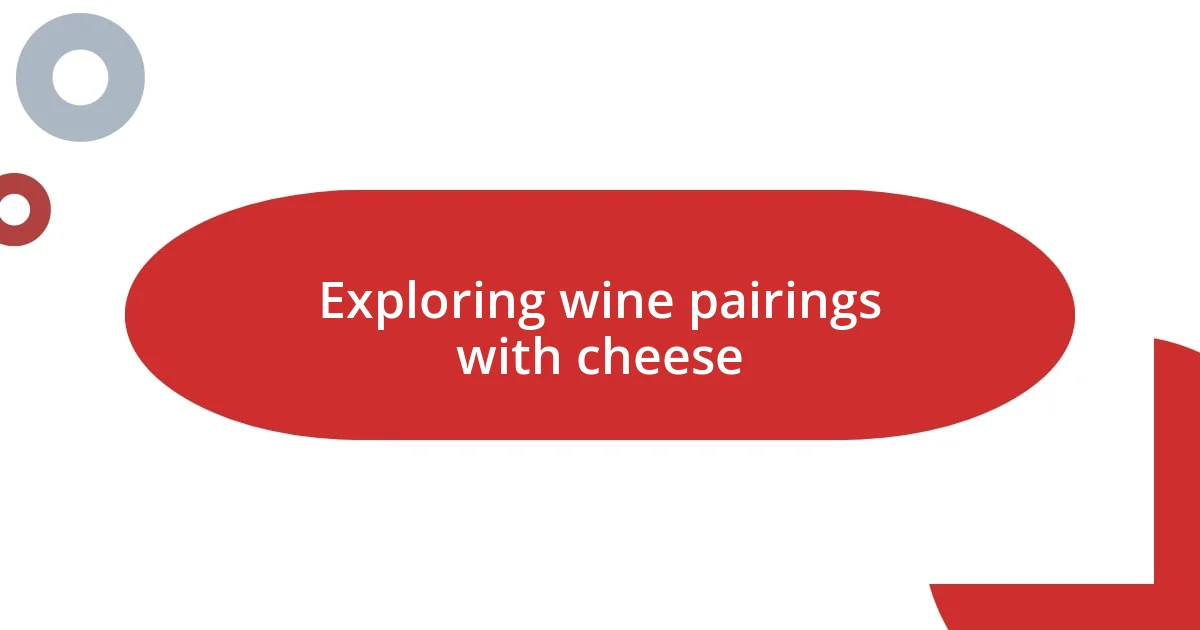
Exploring wine pairings with cheese
One of the most delightful discoveries I’ve made in my cheese journey is how wine can truly enhance the experience. I remember pairing a creamy Camembert with a chilled Sauvignon Blanc, and it was an eye-opening moment. The wine’s crisp acidity cut through the richness of the cheese, creating a refreshing balance that made each sip and bite feel invigorating. Have you ever tried a pairing that felt like it transformed both elements into something greater than the sum of their parts?
Then there’s the robust combo of blue cheese and a strong red, like Cabernet Sauvignon. The wine’s deep, fruity notes meld perfectly with the tangy, bold flavors of the blue. I can still recall a gathering where I served this pairing alongside stories of its origins; the richness of the cheese sparked conversations and laughter, elevating the entire evening into a cherished memory. It truly brings to life the idea that food and wine have a remarkable ability to connect us.
I’ve also had my share of surprises, like pairing a spiced gouda with a sweet dessert wine. The interplay of flavors was unexpected, yet the sweetness of the wine softened the cheese’s spiciness so beautifully. It left me wondering about the unheard possibilities in the world of pairings. Have you experimented with sweet wines? It’s fascinating how breaking away from traditional pairings can open up a whole new realm of enjoyment.










